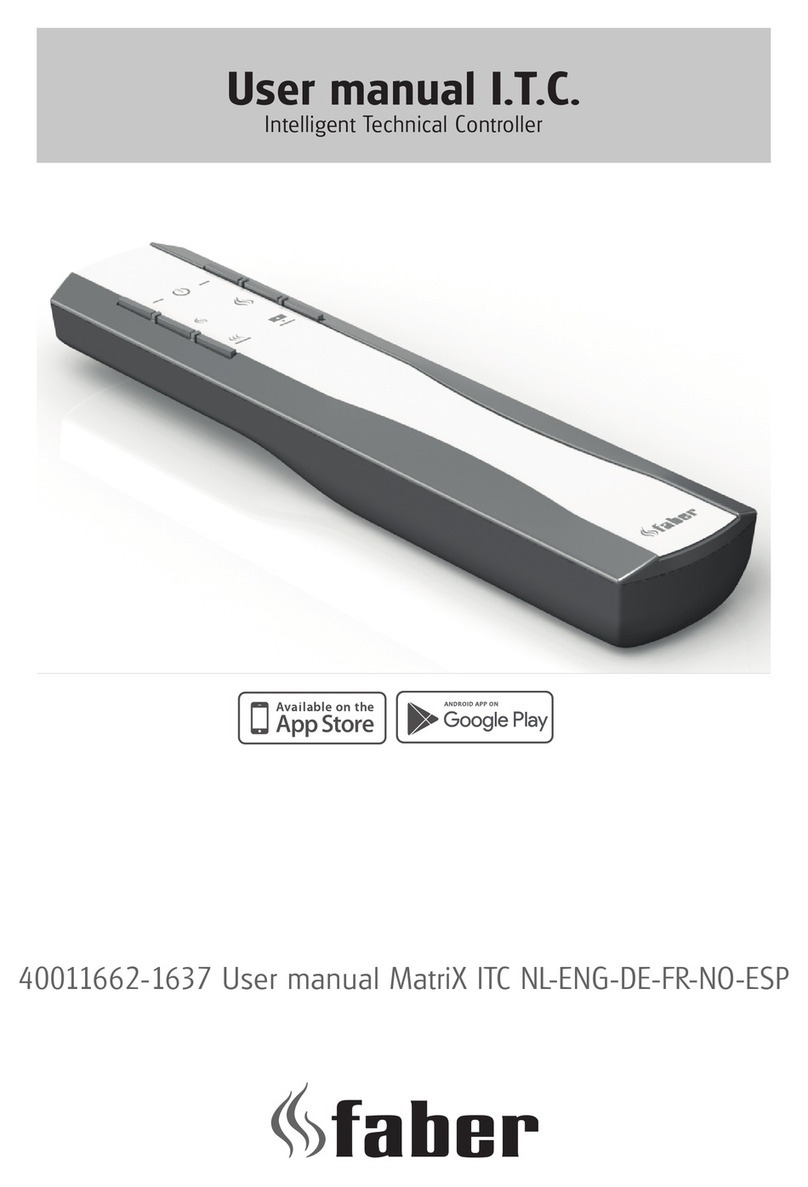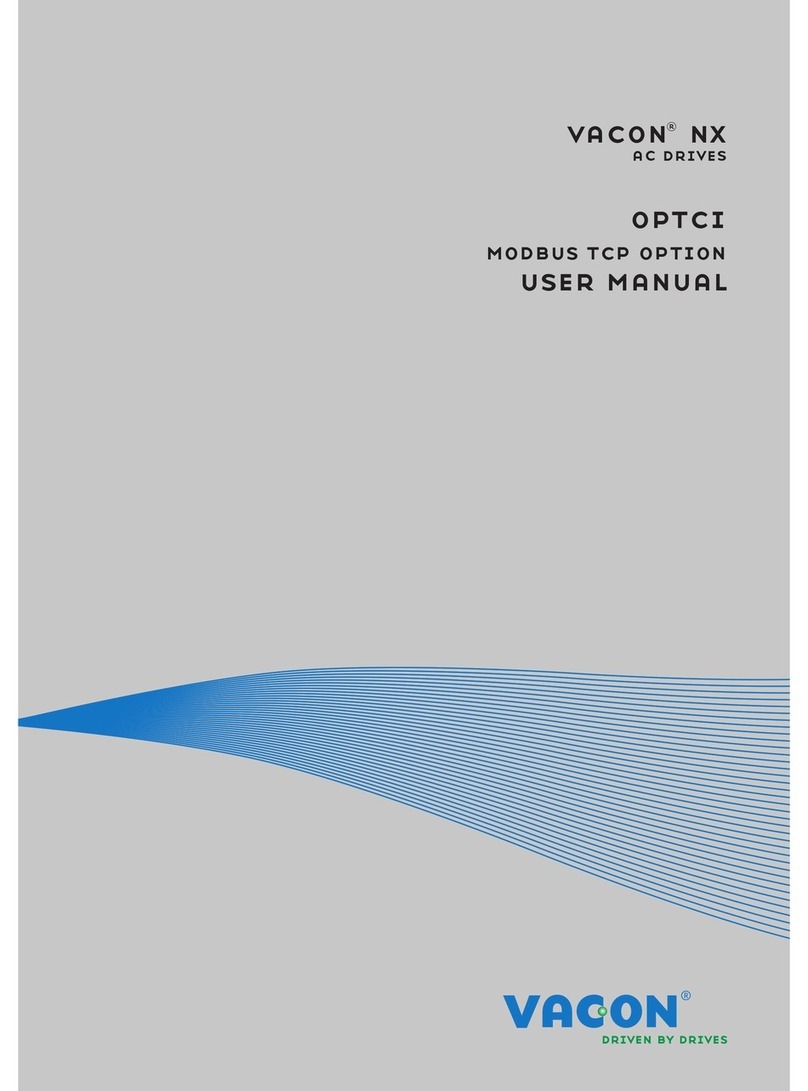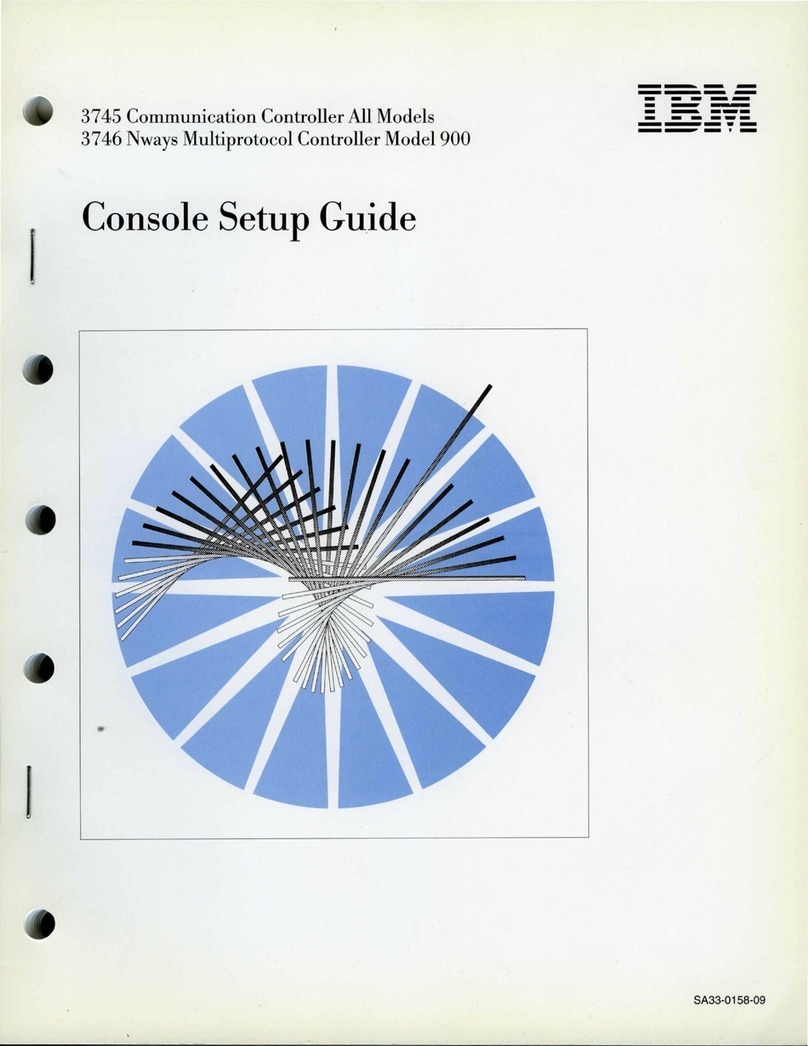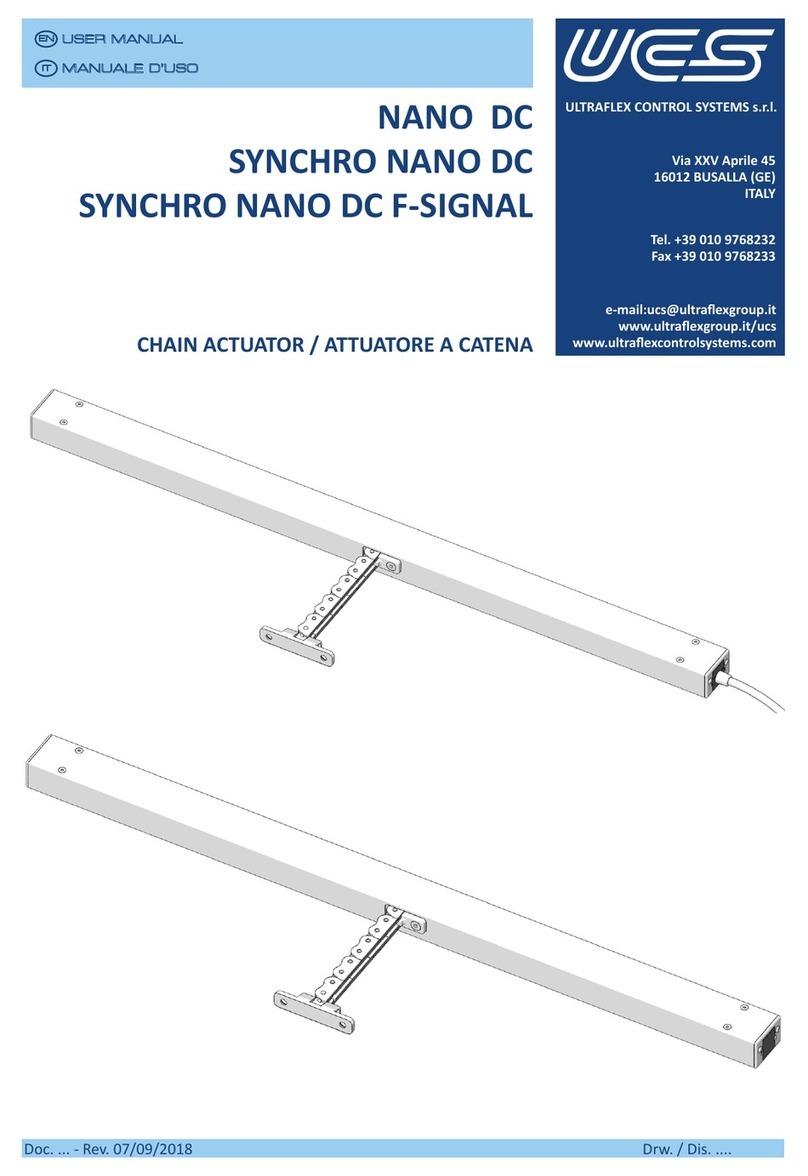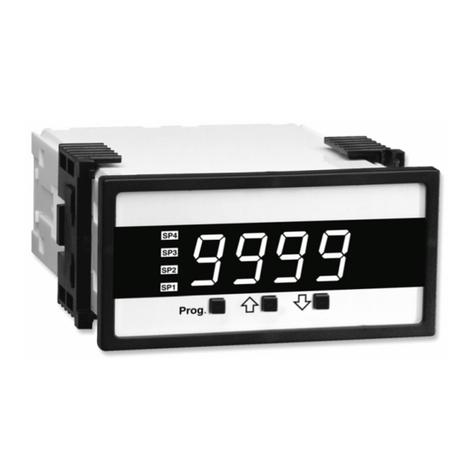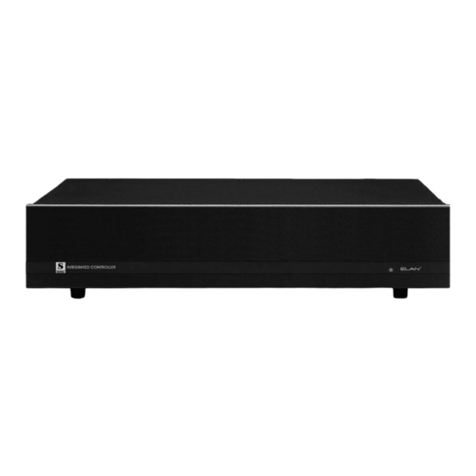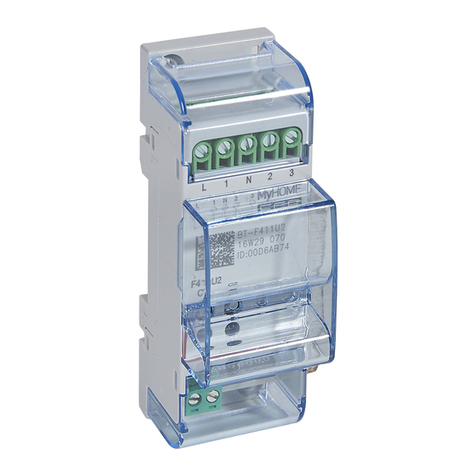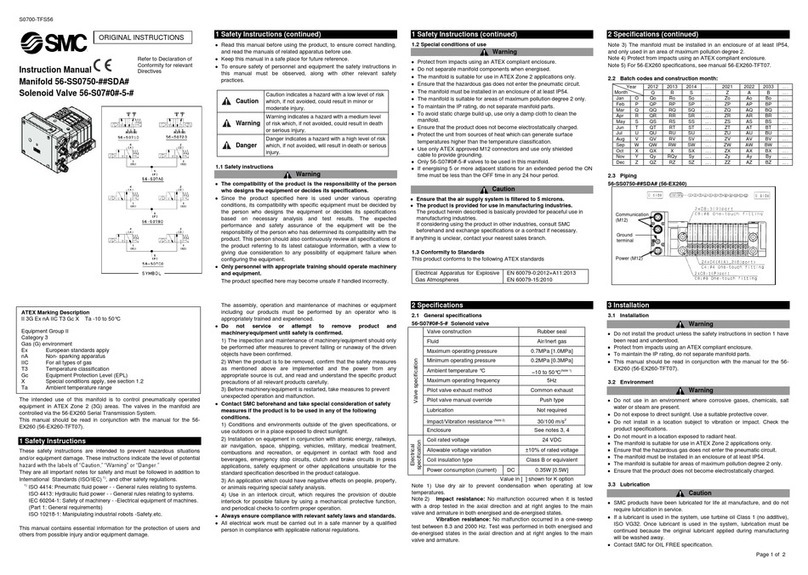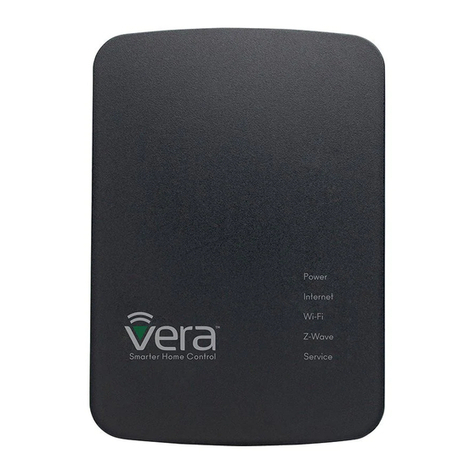High Power 3000 User manual

TEL: (203)-634-3900 FAX: (203)-238-2425
EMAIL: [email protected]
WEB: WWW.HIGHPOWERSECURITY.COM
Dear Customer, if you are having problems using this product, please call Highpower Technical
Support at 800-991-3646. We are here to help and we appreciate your business!
Dear Installer: When using the controller without connection to a fire alarm, place a wire jumper from
terminals #57 and #60 for proper controller operation or use the V+ terminals for power.
MODEL 3000 MULTIFUNCTION DOOR CONTROLLER WITH DELAYED EGRESS
HARDWARE MANUAL
FIRMWARE VERSION 2.1.0
DOCUMENT NUMBER: 980-3000-2.1.0
TABLE OF CONTENTS
CONTROLLER DESCRIPTION.................................................................................................2
KEY FEATURES .......................................................................................................................3
NOTICE OF INSTALLER QUALIFICATION..............................................................................3
ACCESS CONTROL FEATURES .............................................................................................3
CODE TYPES ........................................................................................................................3
SHADOW CARD SYSTEMS ..................................................................................................3
MATRIX AND WIEGAND INTERFACES DESCRIBED..........................................................4
USING THE MATRIX KEYPAD..............................................................................................4
PROGRAMMABLE OUTPUT TIMERS...................................................................................4
REMOTE RELEASE INPUTS.................................................................................................5
DELAYED EGRESS FUNCTIONS ............................................................................................5
DOOR POSITION SWITCH FEATURES................................................................................5
REQUEST TO EXIT OVERRIDE............................................................................................6
FIRE ALARM INTERFACE........................................................................................................6
ADDITIONAL CONTROLLER FEATURES...............................................................................6
VIDEO RECORDER OUTPUT ...............................................................................................6
PANIC SIGNALLING..............................................................................................................6
AUTOMATIC KEY PRESS CLEARING..................................................................................7
WIEGAND LED CONTROL....................................................................................................7
LED INDICATOR OUTPUTS..................................................................................................7
BACKUP BATTERY PASS-THROUGH..................................................................................7
EEPROM MEMORY...............................................................................................................7
SELF-RESETTING DESIGN..................................................................................................7
CODES SPECIFIC TO EACH READER.................................................................................7
HARDWARE CONNECTION.....................................................................................................7
POWER CONNECTION.........................................................................................................7

Page 2 of 30
FIRE ALARM PREPARATION...............................................................................................8
REMOTE RELEASE ..............................................................................................................8
REMOTE RELEASE WIRE CONNECTION DIAGRAM......................................................8
WIEGAND PORTS.................................................................................................................9
WEIGAND PORT WIRE CONNECTION DIAGRAM...........................................................9
TESTED BRANDS OF WIEGAND DEVICES.......................................................................10
PROXIMITY READERS....................................................................................................10
BAR CODE READERS.....................................................................................................10
MAG-STRIPE READERS.................................................................................................10
DELAYED EGRESS PORT..................................................................................................10
DELAYED EGRESS PORT WIRE CONNECTION DIAGRAM.........................................11
LED INDICATOR OUTPUTS................................................................................................12
LED INDICATOR OUTPUTS WIRE CONNECTION DIAGRAM.......................................12
EXTERNAL MATRIX KEYPAD PORT .................................................................................13
MATRIX KEYPAD WIRE CONNECTION DIAGRAM........................................................13
RELAY OUTPUTS 1 AND 2.................................................................................................14
RELAY OUTPUT 1 WIRE CONNECTION DIAGRAM EXAMPLE ....................................15
RELAY OUTPUT 2 WIRE CONNECTION DIAGRAM EXAMPLE ....................................16
CONNECTING A PROXIMITY DETECTOR TO A RELAY OUTPUT ...............................17
TRANSISTOR OUTPUTS 3 AND 4......................................................................................18
TRANSISTOR OUTPUTS 3 AND 4 WIRE CONNECTION DIAGRAM EXAMPLE...........18
FIRE ALARM INTERFACE...................................................................................................18
FIRE ALARM INTERFACE WIRE CONNECTION WITH AUTOMATIC RESET...............20
BATTERY PASS-THROUGH...............................................................................................21
LED INDICATOR FUNCTIONS...............................................................................................21
APPLICATIONS......................................................................................................................22
SAFELY WIRING THE CONTROLLER WITH AN ELECTROMAGNETIC LOCK AND A
PNUEMATIC PUSHBUTTON...............................................................................................22
SAFELY WIRING THE CONTROLLER WITH AN ELECTROMAGNETIC LOCK,
PNUEMATIC PUSHBUTTON AND PIR SENSOR...............................................................23
USING TOGGLE CODES TO LEAVE A DOOR UNLOCKED..............................................24
WIRING DIAGRAM USING TOGGLING OUTPUTS TO LATCH A DOOR IN PASSAGE 24
USING A TRANSISTOR OUTPUT TO CONTROL AN ELECTROMAGNETIC LOCK.........25
TRANSISTOR OUTPUTS WITH FAIL-SAFE DEVICES WIRING DIAGRAM...................25
CONTROLLING FOUR DOORS WITH THE MODEL 3000 .................................................26
MAN-TRAPS (FOR CLEAN ROOMS)..................................................................................26
THIRD-PARTY ADD-ON PERIPHERALS...............................................................................27
CUSTOM WIRING DIAGRAMS AND UNIQUE APPLICATIONS ...........................................28
WARRANTY INFORMATION..................................................................................................28
TROUBLESHOOTING ISSUES ..............................................................................................29
TYPICAL SYSTEM RISER DIAGRAM....................................................................................30
CONTROLLER DESCRIPTION
The Highpower Multifunction Door Controller is a control circuit used to provide delayed egress
for one door and access control functions for two doors. The controller is designed to store access
codes by interfacing with keypads, card readers and biometrics, and can control electromagnetic locks
and electric strikes. Additionally, the controller can be used to interface locks with a fire alarm, can turn
on video recorders during door activity and can provide alarms for unsecured door conditions. This
document will describe the features of this controller for simplified installation and setup.

Page 3 of 30
KEY FEATURES
•Delayed Egress Controller with BOCA and NFPA 101 compatibility modes. Controller provides
both an audible and visual LED response on one door.
•Integrated Access Control with both 26-Bit Wiegand Input and 7-Wire Matrix Keypad Input. Unit
can store 510 users in non-volatile EEPROM memory. Access control module is designed to
work with two doors.
•Wiegand interface has automatic transmission speed adjustment for compatibility with 26-bit
Wiegand readers from many different manufacturers.
•Wiegand port supports multiple Wiegand devices connected simultaneously.
•Integrated Fire Alarm Relay for interfacing the controller to a fire alarm system.
•Four main outputs controlled by five timers. Two outputs are 15 Amp relay outputs and two are
10 Amp FET Transistor outputs.
•Outputs are fused and have surge suppression circuitry.
•Door Monitoring on one door with LED response including Anti-Tailgating and Forced Door
Alarm.
•Active Camera output for turning on video cameras and recorders during door events.
•Fully stand-alone programmable through integrated keypad and led indicators.
NOTICE OF INSTALLER QUALIFICATION
The items listed in this manual may require the services of an individual who is trained in the
application and installation of life safety equipment. All wiring must be in compliance with current NEC
guidelines.
ACCESS CONTROL FEATURES
CODE TYPES
The access control portion of the controller has a memory that is able to hold 510 codes. You may
program codes in memory that can be of six types. Code types include master codes, user codes, one-
time-use codes, “programming add” codes and “programming remove” codes.
Master codes are codes that allow access to programming features. These codes should only be
given to system administrators. They allow an administrator to enter programming mode.
User codes are codes that activate outputs, but do not allow access to programming features.
These codes are given to users for entry.
“One-Time-Use” codes are often called “Service Codes”. These are codes that only allow access
one time. These codes can be given to maintenance people or real-estate salespeople to provide one-
time entry into a door. Since any code can be a one-time-use code, you can have up to 510 one-time-
use codes in memory. You may make a particular one-time-use code work for more than one time. By
adding the code to memory multiple times, the code will work for as many times as it was programmed.
SHADOW CARD SYSTEMS
A new feature added to the controller (with Firmware Version 2.0.0) is support for a “Shadow Card
Systems”. Shadow Card Systems are systems that are designed to simplify the management of user
codes.
In a basic shadow card system, there are two identically coded cards for every user. One of the
cards is issued to the user. The second card is kept with administration. In addition to the sets of user

Page 4 of 30
cards, there are two special cards. These cards are the “Programming Add” and “Programming
Remove” cards.
When Programming Add card is swiped, the controller enters a special programming mode. All
cards swiped after the Programming Add card, are stored in memory as a user card. The Programming
Add card is then swiped at the end of adding all of the user cards, exiting the add mode. All cards
swiped at a particular reader will only work on that reader. If the card is already in memory, the
controller will not allow the addition of the card a second time.
Programming Remove cards allow administration to delete a user code, when a user must be
removed from the system. By swiping the Programming Remove card at a particular reader, the
controller enters another programming mode. Every card swiped after the Programming Remove card
is removed from memory. The second user card that was kept with administration for a particular user
is used in the case where a user card has not been returned or is damaged. This programming mode
deletes all instances of the swiped code in memory for a particular reader. When all the desired codes
have been removed, the same Programming Remove card is again swiped in order to return back to
normal operation. These operations can be performed with no keystrokes on the keypad and is fast
and simple for maintaining a few user codes.
MATRIX AND WIEGAND INTERFACES DESCRIBED
There are two interfaces that can be used to send codes to the controller. The controller has
both a matrix keypad interface and two 26-Bit Wiegand interfaces. The matrix keypad interface allows
the installer to connect a standard matrix keypad to the controller. The matrix keypad can be used for
both access and programming. Multiple matrix keypads can be connected to the matrix keypad port for
this purpose.
In addition to the matrix keypad input, the controller has two Wiegand interfaces can be used to
connect the controller to any standard 26-bit Wiegand device. Since the Wiegand device only sends ID
numbers back to the controller, the matrix keypad must be used for most programming sequences. For
convenience, there is a matrix keypad mounted on the controller’s board, so that users who use just the
Wiegand ports can readily program the unit.
This controller does not use the site code portion of the 26-bit Wiegand data. The controller is
designed to store the lower 16-bits of the data values in order to store codes. Despite this, the
Highpower Wiegand Interface provides full Data Parity Checking over the entire 26-bits to ensure code
integrity. In addition, the Wiegand interface is fully signal de-bounced, in order to filter noisy Wiegand
data, and has automatic detection of data transmission rate, so that 26-bit Wiegand devices from many
brands should work properly. The interface will timeout and recover in the case where the Wiegand
data transmission is incomplete or corrupted.
USING THE MATRIX KEYPAD
The matrix keypad can be used to both program the controller, and send user codes to the
controller. User codes that have been stored in memory as “Reader 1” codes can be activated using
the matrix keypad. For example, if you program the controller to unlock on Port 1 with the code “1234”,
code “1234” will work when the code is entered on the Wiegand Reader 1 or the matrix keypad.
PROGRAMMABLE OUTPUT TIMERS
The controller has 4 programmable outputs. Two of these outputs are 15 Amp relays and the
other two are 10 Amp FET (transistor) outputs. These outputs control up to a 35V control voltage.
Access codes are individually programmed to actuate output timers. There are five output
timers in the controller. The first two output timers activate output 1 (relay) and the additional three
timers are assigned to Outputs 2 through Outputs 4.

Page 5 of 30
When a code is entered, the controller looks up which output timer(s) the code is programmed to
actuate. The duration of each of these timers is programmable. Since each output has a timer
associated to it, the output stays unlocked for the programmed time when actuated. If the timers are
programmed to open for “zero” seconds, the output will toggle instead of time.
Since Relay 1 has two output timers associated with it, you can have two different unlock delays
for Door 1. This feature is commonly used to provide handicapped access. The second timer can be
set for a longer duration, so that Door 1 is left unlocked for a longer time when a handicapped user is
trying to enter.
REMOTE RELEASE INPUTS
In addition to using codes to activate timers, two “remote release” inputs on the controller can be
used. The remote release inputs will activate Timer 1 and Timer 2 with an external signal. This signal
can be a pushbutton or other type of switch that is used to unlock a door from a remote location. Do
not rely on these inputs as a sole form of egress. For most systems, it is required to have (2)
forms of egress, one using the controller, and a second, such as a pneumatic push button
switch, that directly cuts the power to an electromagnetic lock. This port is useful when using
electronic devices for egress like a proximity sensor or remote pushbutton.
DELAYED EGRESS FUNCTIONS
The controller is designed to provide delayed egress functions on Door 1 in addition to access
control functions. The “delayed egress cycle” is a timed unlock of Door 1 that is triggered by a
“Request to Exit” input. This feature is used to allow users to exit out of a locked door after waiting for a
15 or 30 second unlock countdown. There are two standards for this type of operation. These
standards are described in BOCA and NFPA 101 documentation.
In NFPA mode, the controller starts counting down after the Request to Exit input is actuated.
There is a 2 second nuisance delay on the Request to Exit input that prevents false alarms. After a
user holds down the request to exit device for more than two seconds, the delayed egress countdown
begins. The countdown duration is programmable between 15 and 30 seconds. For the next 15 or 30
seconds, the controller “beeps” an audible output and interchanges the led colors between green and
red. At the end of the countdown period, Output 1 unlocks, allowing the user to egress. Once the door
is unlocked, the audible alarm stays on continuously and the Red LED is lit. The unit stays in this state
until a manual reset procedure occurs. An administrator must (1) open the door for more than one
second, (2) close the door and actuate a “manual reset” switch. This switch is usually a key-switch.
After doing the reset, the alarm is halted and the controller returns to run mode.
In BOCA mode, a similar countdown occurs but the reset procedure is different. At the end of
the unlock cycle, a second relock cycle takes place. The relock cycle occurs once the door has been
opened and then re-closed. This relock cycle relocks the door automatically. If the door is re-opened
during this 30 second relock cycle, the relock cycle starts over again. This ensures that there is always
a 30 second window between user passages.
DOOR POSITION SWITCH FEATURES
Because both of the delayed egress modes rely on the opening and closing of the door, a Door
Position Switch (DPS) must be used. Typically, this is a magnetic reed switch that is part of an
electromagnetic lock, or a latch sensor in an electric strike. There is an input in the Delayed Egress
Terminal Block that provides a connection for this switch.
When using a DPS, the controller provides additional features. These features include an anti-
tail-gating feature and a forced door alarm feature on Door #1. The anti-tail-gating feature will relock

Page 6 of 30
Output 1 immediately after a door closure. This prevents another user from “tail-gating”; tail-gating is
passing through the door immediately after another user has entered their code, effectively allowing two
people to pass using the first user’s code.
The Forced Door Alarm is triggered when the locking mechanism of a door is defeated. In this
case, the door is supposed to be locked, but the door position sensor is open. When this occurs, the
audible alarm turns on in order to alert a guard or administrator. The video recorder output is also
activated.
REQUEST TO EXIT OVERRIDE
The delayed egress key switch is used to reset the controller when the controller is in NFPA 101
mode. After counting down, the door unlocks and the controller waits until an administrator performs a
reset using the key switch. Normally, this key switch is a momentary type switch. If you use a two-
position maintained type key switch, instead of the momentary type, the key switch can be used to
override the delay egress countdown. When the countdown is overridden, the request to exit switch will
act as a remote release switch, instead of triggering the delayed egress cycle. This allows an
administrator to use the request to exit device to act as a remote release during special occasions. In
doing this the remote release device will allow immediate passage through door 1. Turning the key
switch back to the run position will cause the controller to perform the delayed egress countdown.
FIRE ALARM INTERFACE
The controller has a relay circuit that is used to interface with a fire alarm system. This relay is
a latching relay circuit that can immediately cut the power to a connected electromagnetic door lock. In
addition to cutting power to a lock, there are relay outputs that can be used for monitoring the status of
the fire alarm.
This fire alarm relay circuit (FAR) can be configured for both manual and automatic reset. In the
manual configuration, the unit will not re-energize an electromagnetic lock unless an external manual
reset is actuated. This manual reset is typically a key-switch. In the automatic configuration, the power
is restored to the locks when the fire alarm is reset. Whenever the fire alarm circuit is used, check
with the Authority Having Jurisdiction for approval of the proposed system connections.
When using the controller without connection to a fire alarm, place a wire jumper from terminals
#57 and #60 for proper controller operation.
ADDITIONAL CONTROLLER FEATURES
VIDEO RECORDER OUTPUT
There is an output on the controller that is specifically designed to trigger an event on a video
recorder. This output is activated when (1) a push on a key on a matrix keypad occurs, (2) a code is
sent to the controller over one of the Wiegand ports, or (3) the Door Position Switch is open due to an
alarm. This output is programmed to stay on for 8 seconds after the event ends. If another event that
occurs during the timing cycle, the second event will cause the cycle to restart.
PANIC SIGNALLING
The controller has a special mode that can be used for panic emergencies or external signaling.
If the matrix keypad is installed as an access device, a user can press both “*” and “#” on the keypad to
activate panic mode. Panic mode will activate programmed output timers. The programmed outputs
can be used to signal a guard or administrator that there is a panic situation. The outputs that the panic
mode activates can be programmed.

Page 7 of 30
AUTOMATIC KEY PRESS CLEARING
The controller will dump any key presses that are entered on the matrix keypad if the code is not
completed in 8 seconds. This feature is disabled when the controller is in programming mode.
WIEGAND LED CONTROL
The Wiegand LED control lines reflect the conditions of Relay 1 and Relay 2. If Relay 1 is
triggered, the LED Control Line on Wiegand Port 1 changes the state of the LED on the Wiegand
Device that is connected to Port 1. If Relay 2 is triggered, the LED Control Line on Wiegand Port 2
changes the state of the LED on the Wiegand Device that is connected to Port 2.
LED INDICATOR OUTPUTS
The controller has outputs for driving external LED indicators. There is an output for the Red,
Amber and Green status LEDs. These outputs allow for external monitoring of the controller status and
provide indications during the Delayed Egress Modes.
BACKUP BATTERY PASS-THROUGH
The controller provides wires that pass the voltage of a back up battery through to an external
power supply.
EEPROM MEMORY
The EEPROM memory on the controller stores all 510 codes and features settings. This data is
retained no matter if there is power to the controller or not. This memory has been tested to perform
over 1,000,000 write cycles, and can provide an infinite number of read cycles. The unit should retain
data for over 90 years without external power. The controller performs internal operations that self-
tests the EEPROM memory, and fully verifies all of the codes that are added to the memory.
SELF-RESETTING DESIGN
The processor of this controller is designed to reset itself if circuit faults should occur.
CODES SPECIFIC TO EACH READER
When a user code is added to the controller, the controller stores which port the code is to be
used on. User codes can be programmed to work on either Reader 1 or Reader 2. In doing this, codes
for a two-door system remain independent to each of the doors.
HARDWARE CONNECTION
POWER CONNECTION
The supply power connections are made at terminals 61 and 60.
The maximum supply voltage is 35 VDC.
TERMINAL # NAME FUNCTION
62 (+V) DC Supply Voltage 35 VDC Maximum
61 GND DC Supply Ground

Page 8 of 30
FIRE ALARM PREPARATION
If the Model 3000 is not being connected to an external fire alarm system, then you must place
a jumper from terminal 60 to terminal 57. If you do not do this, the fire alarm system will not
provide power to the lock outputs (VF). If you are using a fire alarm, be sure to connect the fire
alarm system in the manner described in the Fire Alarm Connection sections.
REMOTE RELEASE
The Remote Release Terminals provide a connection for external switches that are used to
trigger Timer 1 or Timer 2. By activating these timers, the external switches can be used for
the remote release of Door 1 or Door 2.
TERMINAL # NAME FUNCTION
1 Remote Release 1 Opening the Loop from this terminal to ground triggers Timer 1
2 GND DC Supply Ground
3 Remote Release 2 Opening the Loop from this terminal to ground triggers Timer 2
REMOTE RELEASE WIRE CONNECTION DIAGRAM
1 2 3
R
1 R
2
G
N
D
NORMALLY CLOSED
REMOTE RELEASE SWITCH
DOOR 1
NORMALLY CLOSED
REMOTE RELEASE SWITCH
DOOR 2
Remote Release
Terminal Block
TRM0:
NOTE: When using the Remote Release feature, make sure to enable the remote release by setting
the corresponding Remote Release Jumper (JP3 or JP4).

Page 9 of 30
WIEGAND PORTS
The controller has two 26-Bit Wiegand Ports for connection of two Wiegand Devices. Terminals 4
through 9 construct Wiegand Port 1. Terminals 10 through 15 construct Wiegand Port 2.
TERMINAL # NAME FUNCTION
Port 1:
4 (+V) DC Supply Voltage 35 VDC Maximum
5 (+5V) (+5) VDC Regulated
6 GND DC Supply Ground
7 PORT 1:D0 Port 1 Wiegand Data 0 Input
8 PORT 1:D1 Port 1 Wiegand Data 1 Input
9 PORT 1 LED CTRLPort 1 LED Control Line Output
Port 2:
10 (+V) DC Supply Voltage 35 VDC Maximum
11 (+5V) (+5) VDC Regulated
12 GND DC Supply Ground
13 PORT 2:D0 Port 2 Wiegand Data 0 Input
14 PORT 2:D1 Port 2 Wiegand Data 1 Input
15 PORT 2 LED CTRLPort 2 LED Control Line Output
Led Control Lines change the state of the LED on the Wiegand Device. The LED on the first Wiegand
Port indicates the state of Relay Output 1. The LED on the second Wiegand Port indicates the state of
Relay Output 2.
WEIGAND PORT WIRE CONNECTION DIAGRAM
4 5 6
V
+
G
N
D
5
V
Wiegand Port 1
Terminal Bloc
k
TRM1:
7 8
D
0
D
1
9
L
E
D
READER
SUPPLY
POWER
R
E
D
B
L
A
C
K
G
R
E
E
N
W
H
I
T
E
B
R
O
W
N

Page 10 of 30
TESTED BRANDS OF WIEGAND DEVICES
Highpower strives to make the Model 3000 as compatible as possible with Wiegand devices from many
manufacturers. In accordance with this goal, we have created our Wiegand interface to automatically
detect the transmission speed of any Wiegand device connected.
As a result, we are compiling a list of Wiegand devices that have been tested with the Model 3000.
These devices include the following:
PROXIMITY READERS
All 26-Bit Wiegand “Revision D” model readers from AWID (Applied Wireless ID, Inc.)
Note: This brand is highly recommended for use with the Model 3000.
26-Bit Wiegand “Pyramid” Reader Heads from Keri Systems. (Models 300H, 500H).
Note: These are good readers to use if you require HID Card compatibility.
BAR CODE READERS
All 26-bit Wiegand models from IBC (International Bar Code, Inc.)
Note: Use the “Smart” models of IBC products when using extended bar codes.
MAG-STRIPE READERS
All 26-Bit Wiegand models from IBC (International Bar Code, Inc.)
Note: Use the “Smart” models of IBC products when using custom track configurations.
Note to Installers: If you have successfully used another brand of reader with our controller or are
having problems with a particular model of reader, we want to hear from you! Your comments are
appreciated. Please call us direct at 800-991-3646.
Note to Hardware Manufacturers: If you would like us to test your access control product with this
controller, please contact Highpower directly. We would be pleased to add your qualified product to our
list.
DELAYED EGRESS PORT
The Delayed Egress Terminal Block has inputs for the Request to Exit, Door Position Switch, External
Reset key-switch and an Output for the Audible Alarm (Sonalert).
TERMINAL # NAME FUNCTION
16 GND DC Supply Ground
17 REX Request to Exit Loop Input
18 GND DC Supply Ground
19 DPS Door Position Switch Input
20 GND DC Supply Ground
21 RST External Key-Switch Reset Input
22 SON Audible Signal Output (100 mA MAX)
23 GND DC Supply Ground

Page 11 of 30
DELAYED EGRESS PORT WIRE CONNECTION DIAGRAM
16 17 18
REX DPS
Delayed Egress Port
Terminal Block
TRM3:
19 20
RST
21 22
SON
23
NORMALLY CLOSED
REQUEST TO EXIT SWITCH
NORMALLY OPEN
(HELD CLOSED)
DOOR POSITION
MAGNETIC SWITCH
NORMALLY
OPEN
RESET KEY-
SWITCH
AUDIBLE
ALARM
(SONALERT)
+ -

Page 12 of 30
LED INDICATOR OUTPUTS
The LED Indicator outputs are used to monitor the status of the controller externally. These signals are
usually sent to indicators that are mounted externally with the matrix keypad. There is an output in this
terminal block group called “ACT” (active) that is used to trigger a video recorder during events. These
outputs can also be used to power small relays (< 100 mA).
TERMINAL # NAME FUNCTION
24 5V (+5) Volt regulated voltage for external LED power.
25 GREEN Green Status LED Transistor Output
26 AMBER Amber Status LED Transistor Output
27 RED Red Status LED Transistor Output
28 ACT Event Active Output used to trigger a video recorder
29 GND DC Supply Ground
LED INDICATOR OUTPUTS WIRE CONNECTION DIAGRAM
TO VIDEO
RECORDER
TRIGGER
INPUT
G
24 25 26
5
V
A
M
B
E
R
LED Indicator Outputs
Terminal Block
TRM4:
27 28
A
C
T
I
V
E
29
G
R
E
E
N
R
E
D
G
N
D
GREEN
LED
RED LED
AMBER
LED
+ -
+ -
+ -
A
R

Page 13 of 30
EXTERNAL MATRIX KEYPAD PORT
An external matrix keypad can be connected to the controller. This keypad can both be used as an
access device or a programming interface. Using the matrix keypad externally also allows for Panic
Signaling.
TERMINAL # NAME FUNCTION
30 C1 Matrix Keypad Column 1
31 C2 Matrix Keypad Column 2
32 C3 Matrix Keypad Column 3
33 R1 Matrix Keypad Row 1
34 R2 Matrix Keypad Row 2
35 R3 Matrix Keypad Row 3
36 R4 Matrix Keypad Row 4
37 SH Keypad Shield Grounding
MATRIX KEYPAD WIRE CONNECTION DIAGRAM
30 31 32
C
1 C
3
Matrix Keypad
Terminal Block
TRM5:
33 34
R
2
35
C
2 R
1 R
3
37
S
H
R
4
36
1 2 3
4 5 6
7 8 9
* 0 #

Page 14 of 30
RELAY OUTPUTS 1 AND 2
The relay outputs have a common configuration. These outputs are used mainly to run an
electromagnetic lock or electric strike. The maximum current that can be switched by these outputs is
15 Amps.
TERMINAL # NAME FUNCTION
Output 1:
38 VF Supply Voltage from Fire Alarm Relay
39 NC Normally Closed relay contact
40 C Common relay contact
41 NO Normally Open relay contact
42 (+V) DC Supply Voltage 35 VDC Maximum
43 GND DC Supply Ground
Output 2:
44 VF Supply Voltage from Fire Alarm Relay
45 NC Normally Closed relay contact
46 C Common relay contact
47 NO Normally Open relay contact
48 (+V) DC Supply Voltage 35 VDC Maximum
49 GND DC Supply Ground
See connection diagram on next page.

Page 15 of 30
RELAY OUTPUT 1 WIRE CONNECTION DIAGRAM EXAMPLE
V
F
CV
+
N
CN
O
G
N
D
V+ GND
JP7
Relay Output
1
Common
J
JP7:
Note: This jumper is used to connect the common of Relay 1 to either
Ground, V+ or neither.
Thunderbolt Electromagnetic
V+ (1)
GND (2)
Electric Door
+
GND
1N4005
DIODE*
38 39 40
Relay Output
1
Terminal Block
TRM6:
41 42 43
1N4005
DIODE*
* Diode may be required
certain lock models to
surge

Page 16 of 30
RELAY OUTPUT 2 WIRE CONNECTION DIAGRAM EXAMPLE
V
F C V
+
N
C N
O
G
N
D
V+ GND
JP8
Relay Output 2
Common Jumper
JP8:
Note: This jumper is used to connect the common of Relay 2 to either
Ground, V+ or neither.
Thunderbolt Electromagnetic Lock
V+ (1) GND (2)
Electric Door Strike
+
GND
1N4005
DIODE*
44 45 46
Relay Output 2
Terminal Block
TRM7:
47 48 49
1N4005
DIODE*
* Diode may be required on
certain lock models to provide
surge suppression.

Page 17 of 30
CONNECTING A PROXIMITY DETECTOR TO A RELAY OUTPUT
38 39 40
V
F C
Relay Output 1
Terminal Block
TRM6:
41 42
V
+
43
N
C N
O
G
N
D
V+ GND
JP7
Relay Output 1
Common Jumper
JP7:
Note: This jumper is used to connect the common of Relay 1 to either
Ground, V+ or neither. Remove the jumper for this configuration.
Thunderbolt Electromagnetic Lock
V+ (1) GND (2)
NC
C
(V+)
GND
PIR Presence Sensor
1N4005
DIODE* * Diode may be required on
certain lock models to provide
surge suppression.

Page 18 of 30
TRANSISTOR OUTPUTS 3 AND 4
The transistor outputs have a common configuration. These are auxiliary outputs that can run external
indicators, counters or extra access control devices. The maximum current that can be switched by
these outputs is 5 Amps.
TERMINAL # NAME FUNCTION
50 VF Supply Voltage from Fire Alarm Relay
51 3 Transistor Output 3
52 4 Transistor Output 4
53 (+V) DC Supply Voltage 35 VDC Maximum
TRANSISTOR OUTPUTS 3 AND 4 WIRE CONNECTION DIAGRAM EXAMPLE
50 51 52
V
F 4
Transistor Outputs
3 + 4 Terminal Block
TRM8:
53
3 V
+
Electric Door Strike
+
GND
* Lock models without surge suppression require a diode to
suppress voltage kickback.
1N4005
DIODE*
FIRE ALARM INTERFACE
The fire alarm interface is a latching relay that is used to connect the controller to the fire alarm. The
interface controls the “VF” signal in the output terminal blocks. By using the “VF” signal to power an
electromagnetic lock, the power is cut immediately when the fire alarm is triggered. Please contact
your local fire authority as to the configuration of the Fire Alarm Relay Circuit.
TERMINAL # NAME FUNCTION
54 TRIPPED External Monitoring - Tripped Fire Alarm Relay (Supply Voltage)
55 GND DC Supply Ground
56 OK External Monitoring - Fire Alarm Relay OK (Supply Voltage)
57 RST External Reset Switch
58 RST External Reset Switch
59 CON External Fire Alarm Dry Contact
60 CON External Fire Alarm Dry Contact
See connection diagram on next page.

Page 19 of 30
FIRE ALARM INTERFACE WIRE CONNECTION WITH MANUAL EXTERNAL RESET
OK
54 55 56
T
R
I
P
P
E
D O
K
Fire Alarm
Terminal Block
TRM9:
57 58
R
S
T
59
G
N
D
R
S
T
C
O
N
C
O
N
60
NORMALLY
OPEN
MANUAL FIRE
ALARM RELAY
RESET
(KEYSWITCH)
NORMALLY OPEN
EXTERNAL FIRE ALARM RELAY
CONTACT
(HELD CLOSED BY FIRE ALARM
SYSTEM DURING NORMAL
OPERATION)
EXTERNAL LAMP
INDICATES TRIPPED
FIRE ALARM RELAY
CONDITION
T
+ -
+ -
EXTERNAL LAMP
INDICATES OK FIRE
ALARM RELAY
CONDITION
* R2
* R1
* NOTE: Since the output voltage of the “TRIPPED” and “OK” terminals is (V+), a
resistor is required if you are using LEDs as indicators. If using lamps, make
sure that the operating voltage of the lamp is equal to the supply voltage (V+). A
table below provides suggested resistor values for typicalLEDs.
Controller Supply Voltage (V+) Recommended LED Resistor Ranges
12V 360—500 Ohm
24V 760—1K Ohm

Page 20 of 30
FIRE ALARM INTERFACE WIRE CONNECTION WITH AUTOMATIC RESET
OK
54 55 56
T
R
I
P
P
E
D O
K
Fire Alarm
Terminal Block
TRM9:
57 58
R
S
T
59
G
N
D
R
S
T
C
O
N
C
O
N
60
AUTOMATIC
FIRE ALARM
RELAY
RESET JUMPER
NORMALLY OPEN
EXTERNAL FIRE ALARM RELAY
CONTACT
(HELD CLOSED BY FIRE ALARM
SYSTEM DURING NORMAL
OPERATION)
EXTERNAL LAMP
INDICATES TRIPPED
FIRE ALARM RELAY
CONDITION
T
+ -
+ -
EXTERNAL LAMP
INDICATES OK FIRE
ALARM RELAY
CONDITION
* R2
* R1
* NOTE: Since the output voltage of the “TRIPPED” and “OK” terminals is (V+), a
resistor is required if you are using LEDs as indicators. If using lamps, make
sure that the operating voltage of the lamp is equal to the supply voltage (V+). A
table below provides suggested resistor values for typicalLEDs.
Controller Supply Voltage (V+) Recommended LED Resistor Ranges
12V 360—500 Ohm
24V 760—1K Ohm
Other manuals for 3000
1
Table of contents
Other High Power Controllers manuals
Popular Controllers manuals by other brands
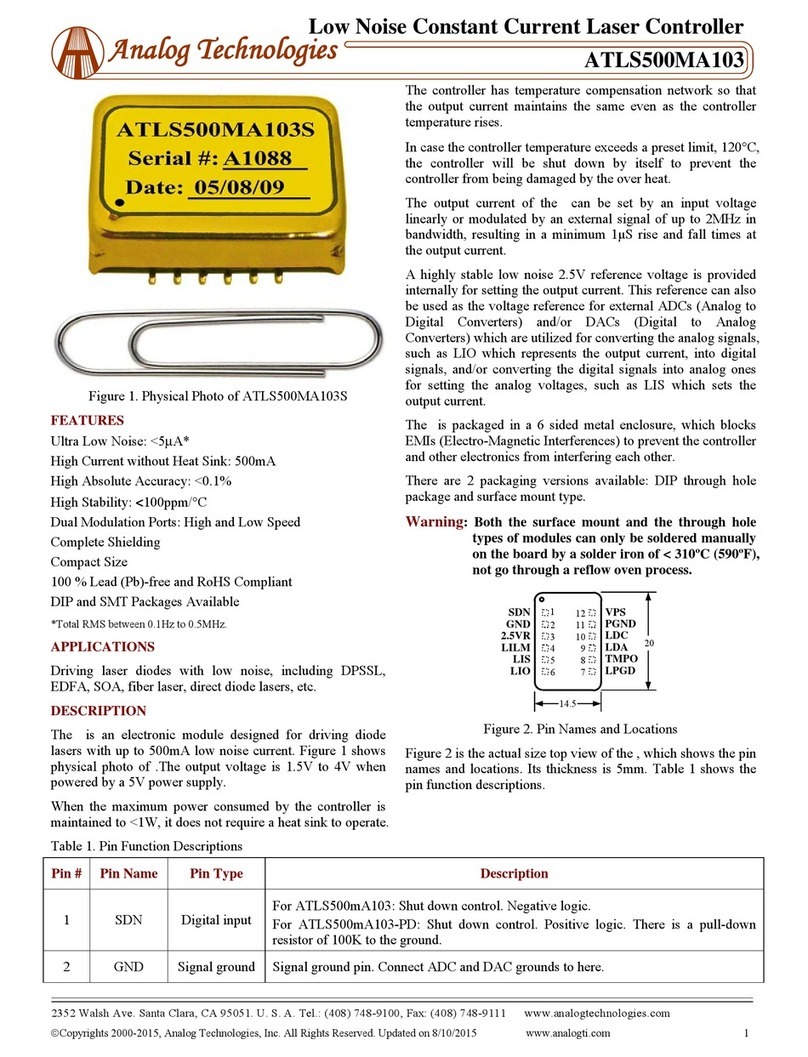
Analog Technologies
Analog Technologies ATLS500MA103 quick start guide
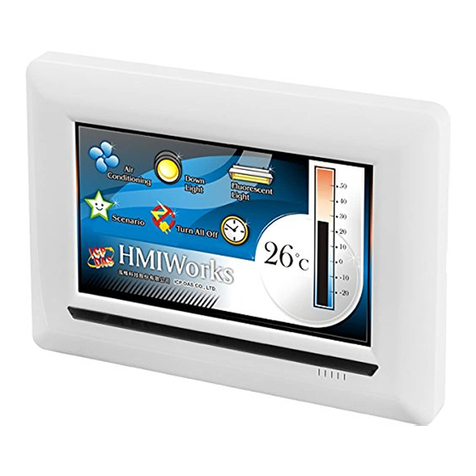
ICP DAS USA
ICP DAS USA TPD-703 quick start
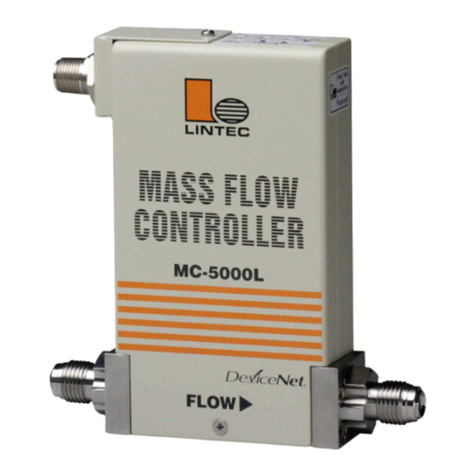
Lintec
Lintec MC-5000L Series instruction manual
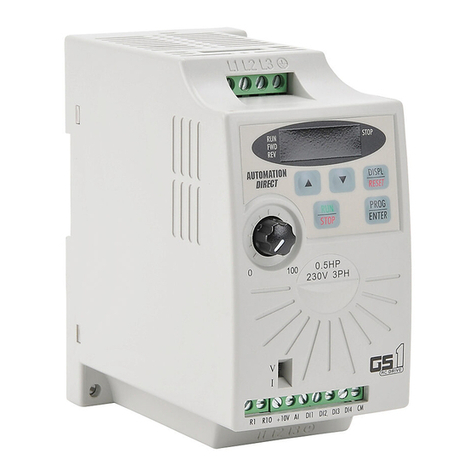
Automationdirect.com
Automationdirect.com GS1-10P2 user manual
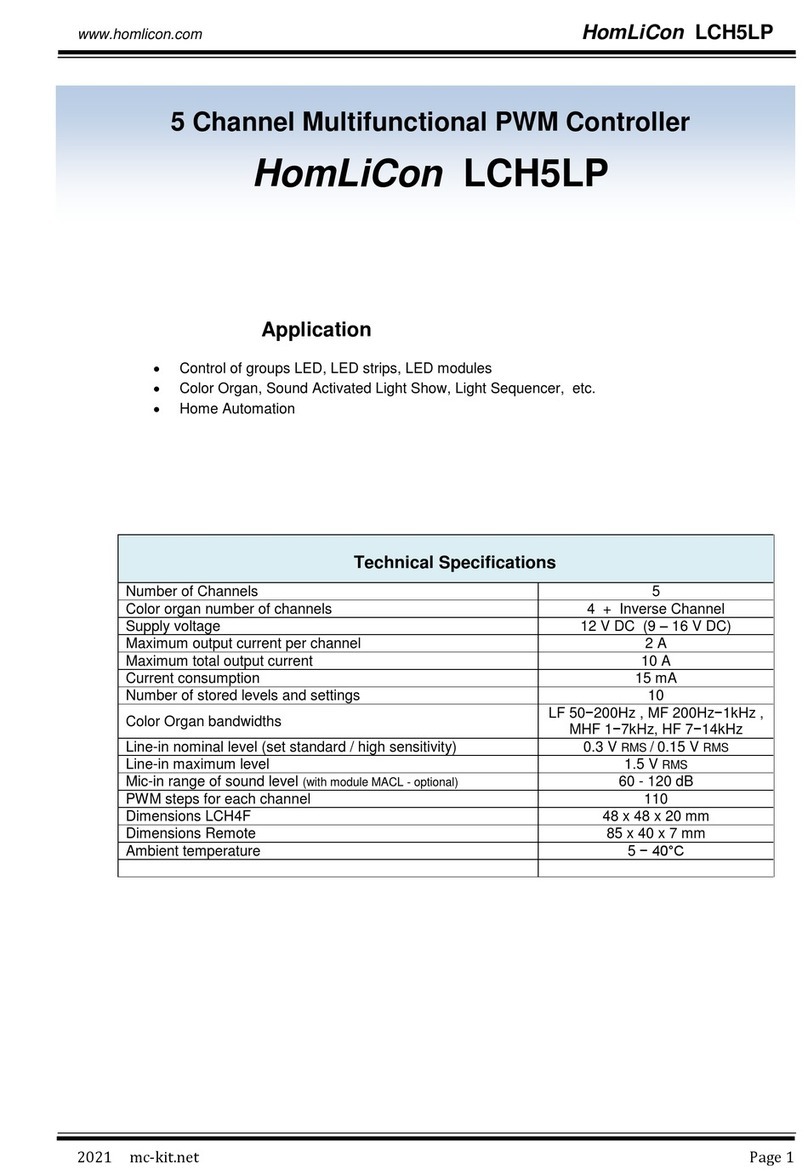
HomLiCon
HomLiCon LCH5LP quick start guide
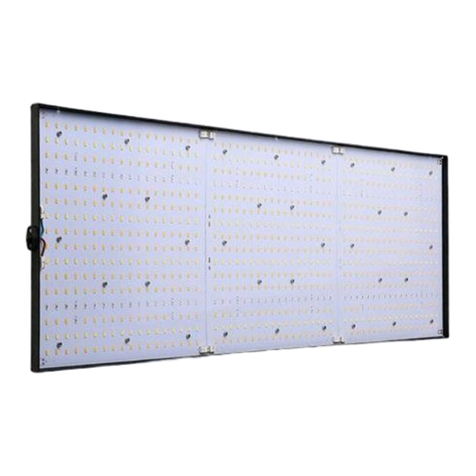
Phytolite
Phytolite Resina Q-Board 120 Series instruction manual


